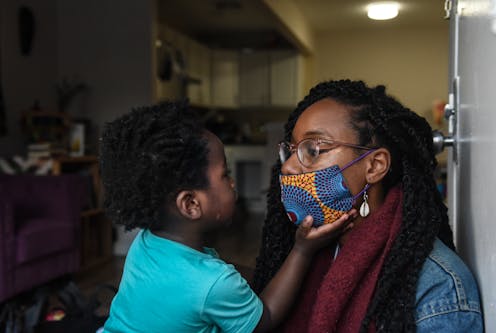Racism at the county level associated with increased COVID-19 cases and deaths
Blacks are at greater risk of dying from COVID-19 than whites. A study that examined racism at the country level had surprising results.

The COVID-19 pandemic has affected all people, but not necessarily in the same way.
Scientists have shown that racial and ethnic minorities are more likely than white people to catch, be hospitalized because of and ultimately die from the virus.
In explaining these findings, researchers often point to patterns within society that advantage white people over racial and ethnic minorities.
These patterns reflect systemic racism or institutional racism. As Mary Frances O'Dowd, a senior lecturer of Indigenous Studies at CQUniversity Australia, explains, these refer “to how ideas of white superiority are captured in everyday thinking at a systems level: taking in the big picture of how society operates, rather than looking at one-on-one interactions.”
As researchers who study diversity and health, we put this idea to the test. Specifically, we tested whether different forms of racism at the county level were linked to COVID-19 cases and deaths. The answer is yes, racism predicts COVID-19 outcomes, even after taking into account a host of other health and demographic factors.
Racism at the county level
We focused on two kinds of racial attitudes. The first, explicit, represents those attitudes that people intentionally maintain. Here, people express negative attitudes toward a group, or toward people they think belong to that group. An example came in Minnesota, where health workers offering free COVID-19 testing were called various racial epithets.
We also examined implicit racial attitudes. These are the automatic, unintentional responses people have. Though they take a different form, implicit racial attitudes can and do affect people’s behaviors. A health-related example comes when people make an automatic assumption that “actual physicians or nurses” are white.
Most social science researchers focus on explicit and implicit attitudes that individuals have and the way these attitudes influence individual behavior and decisions. But, as it turns out, the relationship between personal biases and subsequent behaviors is not necessarily a strong one.
A different story emerges, though, when looking at bias at the aggregate level, or a broader view seen by bringing together various parts.
As University of North Carolina psychology professor Keith Payne and his colleagues explain, people’s social interactions, the media they consume and other environmental cues are likely to influence their attitudes about race. If this is the case, then racial attitudes captured at aggregate level, whether a metropolitan area, county or state, reflect the bias of crowds.
Collective biases, more than individual ones, help to shape people and systems. To illustrate, researchers have shown that community-level racism can help explain racial gaps in preterm births and infant birth weight, lethal force used by police, punishment in schools and reactions to social justice movements, among others.
Extending this work, we focused on racial attitudes at the county level. We asked how the racial attitudes of the broader community influence COVID-19 health-related outcomes.

Our study design
In our recent study, we collected data from a variety of publicly available data sets. The racial attitude data came from a long-time Harvard study, and the researchers post the data (without identifying information) online. This meant taking over 80,000 responses and aggregating these data to the county level. We ultimately had data for 817 counties in the U.S.
For COVID-19 cases and deaths, we relied on the data from USAFacts. This is the same source the Centers for Disease Control and Prevention uses. We looked at the total cases and deaths from Jan. 22 through Aug. 31, 2020.
We also wanted to consider other factors that might impact the results, all of which were publicly available. This included how county residents rated their own health, if they had plenty of food, if they had health insurance and their family income. We also accounted for county demographics, including the residents’ age, gender, race and ethnicity.
Racism and COVID-19
We found that, even after taking into account the health and demographics of the county residents, explicit and implicit racial attitudes were related to COVID-19 cases. The stronger the racism, the more COVID-19 cases the county recorded.
Further, the relationship between racism and COVID-19 cases was stronger when counties had a high number of Black residents. We also found that implicit racial attitudes predicted COVID-19 deaths. Again, this was even beyond the effects of the health and demographic factors.
In short, racism at the county level was predictive of COVID-19 health-related outcomes.
Implications
Our results provide clear evidence that county-level racism is linked with COVID-19 health-related outcomes.
But why? We suggest that, when examined at the aggregate level, racial attitudes reflect systemic forms of racism. They show the bias of crowds and the deeper biases that are embedded in society. Systemic forms of racism are those where values, policies and the ways we go about life are structured in a way that advantage white people over racial and ethnic minorities. Racial disparities in access to health, quality education, safe housing, wealth and the criminal justice system are just a few indicators, out of many.
Our study is not the only one to show the impact of racism on health-related outcomes. Consider a recent study of machine learning. Here, the researchers found that health inequalities over time resulted in algorithms that were racially biased. The end result was that software used to manage population health actually advantaged white people over Black people.
And, as we noted before, county-level racism is linked with other health outcomes, including mortality rates and infant health.
Public health implications
Our results also underscore the importance of recognizing that racism is a public health issue. A variety of organizations, like the American Public Health Association and the American Medical Association, have made statements to this effect.
[Deep knowledge, daily. Sign up for The Conversation’s newsletter.]
We see many action steps to take.
First, health care providers should participate in regular training aimed at recognizing their explicit and implicit racial biases. This is a necessary first step toward reducing health inequalities among racial and ethnic minority patients.
Beyond a focus on individual health care providers, local, county and state governments can take steps to improve access and quality of health care for all people.
The authors do not work for, consult, own shares in or receive funding from any company or organisation that would benefit from this article, and have disclosed no relevant affiliations beyond their academic appointment.
Read These Next
What’s at stake in Trump’s executive order aiming to curb state-level AI regulation
In the absence of comprehensive federal AI regulation, states have stepped in. The Trump administration,…
Data centers need electricity fast, but utilities need years to build power plants – who should pay?
How many data centers will be built – and how much electricity they’ll need – is uncertain. Being…
Sleep problems and depression can be a vicious cycle, especially during pregnancy − here’s why it’s
Inadequate sleep can have negative downstream effects on everyday cognitive functioning and mental health,…





